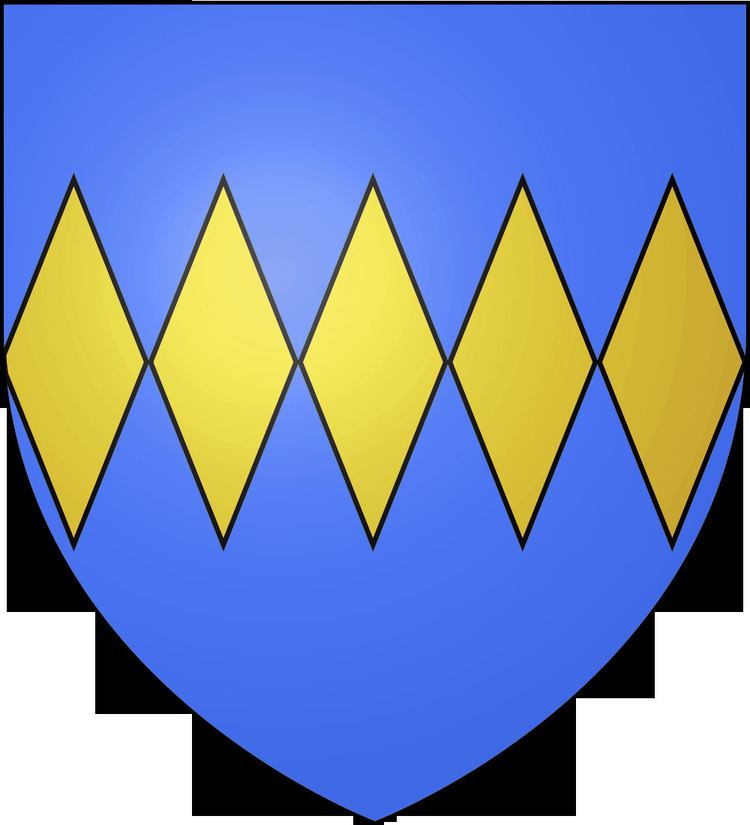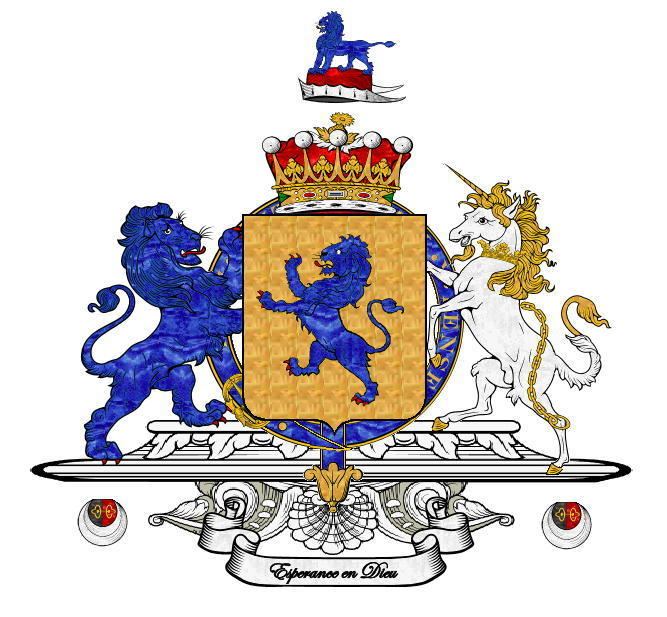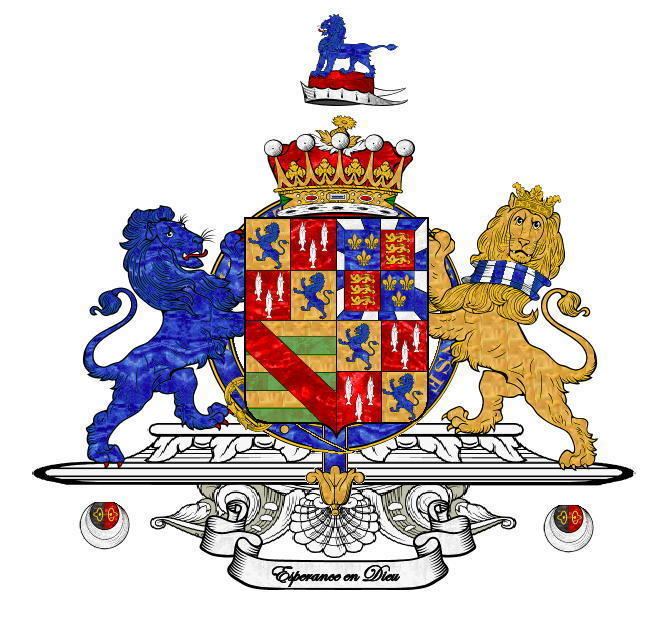Founded 1067 | ||
 | ||
Country Kingdom of England, United Kingdom Titles Duke of NorthumberlandEarl of WorcesterEarl of EgremontBaron Percy Founder William de Percy (d.1096), 1st feudal baron of Topcliffe Current head Ralph Percy, 12th Duke of Northumberland | ||
The House of Percy (old French Perci) were the most powerful noble family in northern England for much of the Middle Ages, having descended from William de Percy (d.1096), a Norman who crossed over to England after William the Conqueror in early December 1067, was created 1st feudal baron of Topcliffe in Yorkshire, and was rebuilding York Castle in 1070. The name derives from the manor of Percy-en-Auge in Normandy, the home of the family at the time of the Norman Conquest. Members have held the titles of Earl of Northumberland or Duke of Northumberland to this day, in addition to Baron Percy and other titles. The Percy surname twice died out in the male line but was re-adopted by the husband of a Percy heiress and by their descendants. In the 12th century, the original Percy line was represented by Agnes de Percy, whose son by her husband Joscelin of Louvain adopted the surname Percy. Again in the 18th century, the heiress Elizabeth Seymour married Sir Hugh Smithson, who adopted the surname Percy and was created Duke of Northumberland.
Contents

Earls of Northumberland

William de Percy, 1st Baron Percy, who came from the village of Percy in Normandy, was in the train of William I. After arriving in England following the Harrying of the North (1069–70), he was bestowed modest estates in Yorkshire by Hugh d'Avranches. However, by the reign of Henry II the family was represented by only an heiress, Agnes de Percy (d.1203) following the death of the third feudal baron. As her dowry contained the manor of Topcliffe in Yorkshire, Adeliza of Louvain, the widowed and remarried second wife of Henry I, arranged the marriage of Agnes with her own young half-brother, Joscelin of Louvain. After their wedding, the nobleman from the Duchy of Brabant in the Holy Roman Empire settled in England. He adopted the surname Percy and his descendants were later created Earls of Northumberland. The Percys' line would go on to play a large role in the history of both England and Scotland. As nearly every Percy was a Warden of the Marches, Scottish affairs were often of more concern than those in England.

In 1309 Henry de Percy, 1st Baron Percy purchased Alnwick Castle from Antony Bek, Bishop of Durham. The castle had been founded in the late 11th century by Ivo de Vesci, a Norman nobleman from Vassy, Calvados in Normandy. However, by the early 14th century, the English line of the De Vesci family had become extinct. The family's property and estates had been put into the guardianship of Bek, who sold them to the Percys. From this time the fortunes of the Percys, though they still held their Yorkshire lands and titles, were linked permanently with Alnwick and its castle.
Henry de Percy, 2nd Baron Percy, who was granted the lands of Patrick IV, Earl of March, in Northumberland, by Edward II in 1316, began to improve the size and defences of the castle. He was appointed to Edward III's Council in 1327 and was given the manor and castle of Skipton. Was granted, by Edward III, the castle and barony of Warkworth in 1328. He was at the siege of Dunbar and the Battle of Halidon Hill and was subsequently appointed constable of Berwick-upon-Tweed. In 1346, Henry commanded the right wing of the English Army which defeated a larger Scottish force at the Battle of Neville's Cross. His son, Henry de Percy, 3rd Baron Percy married Mary of Lancaster, an aunt of John of Gaunt's wife Blanche of Lancaster.
In 1377 the next Henry Percy, was created Earl of Northumberland, which title he was given after the coronation of Richard II. Nor was this all, for he was that Northumberland whose doings in the next reign fill so large a part of Shakespeare's Henry IV, and he was the father of the most famous Percy of all, Henry Percy the fifth, better known as "Hotspur." Hotspur never became Earl of Northumberland, being slain at Shrewsbury in the lifetime of his father, whose estates were forfeited under attainder on account of the rebellion of himself and his son against King Henry IV.
Henry V restored Hotspur's son, the second Earl, to his family honours, and the Percys were staunch Lancastrians during the Wars of the Roses which followed, the third Earl and three of his brothers losing their lives in the cause.
The fourth Earl was involved in the political manoeuvrings of the last Yorkist kings Edward IV and Richard III. Either through indecision or treachery, he did not respond in a timely manner at the Battle of Bosworth Field, and thus helped cause his ally Richard III's defeat at the hands of Henry Tudor (who became Henry VII). In 1489, he was pulled from his horse and murdered by some of his tenants.
The fifth Earl displayed magnificence in his tastes, and being one of the richest magnates of his day, kept a very large household establishment.
Henry Percy, the sixth Earl of Northumberland, loved Anne Boleyn, and was her accepted suitor before Henry VIII married her. He married later to the daughter of the Earl of Shrewsbury, but as he died without a son, his nephew, Thomas Percy became the seventh Earl.
Thereafter, a succession of plots and counterplots—the Rising of the North, the plots to liberate Mary Queen of Scots, and the Gunpowder Plot – each claimed a Percy among their adherents. On this account the eighth and ninth Earls spent many years in the Tower, but the tenth Earl, Algernon, fought for King Charles in the Civil War, the male line of the Percy-Louvain house ending with Josceline, the eleventh Earl. The heiress to the vast Percy estates married the Duke of Somerset; and her granddaughter married a Yorkshire knight, Sir Hugh Smithson, who in 1766 was created the first Duke of Northumberland and Earl Percy, and it is their descendants who now represent the famous old house. One of Sir Hugh's illegitimate sons, James Smithson, left behind a bequest to found the Smithsonian Institution.
The current duke lives at Alnwick Castle and Syon House, just outside London. Parts of the Harry Potter movies were shot at Alnwick, and there is a scene in The Madness of King George (when Pitt walks backward from the king down a long corridor) filmed at Syon.
The title was created for the third time in 1766 for Hugh Percy, 2nd Earl of Northumberland, the former Sir Hugh Smithson, 4th Baronet (1714–1786), who had assumed by Act of Parliament in 1750 for himself and his descendants the surname Percy, due to his having married in 1740 the daughter of Algernon Seymour, 7th Duke of Somerset (1684–1750), whose mother Lady Elizabeth Percy (1667–1722), was the last of the senior blood line of the ancient House of Percy, being the only surviving child of Joceline Percy, 11th Earl of Northumberland (1644–1670). In 1749 King George II created Algernon who had inherited the Dukedom of Somerset in 1748 Earl of Northumberland and by courtesy title (for eldest male heir) Baron Warkworth, of Warkworth Castle in the County of Northumberland with special remainder to his son-in-law Sir Hugh Smithson, 4th Baronet.
The above steps formed a deliberate move to allow ancient names and titles of the Percys to be revived in the male-heir exhausted senior branch of the Dukedom of Somerset which at that time was about to see its largest removal, to another noble but very cadet branch (a fourth cousin) on Algernon's death; Algernon was also created Earl of Egremont at the same time with a different remainder – see this article for further information).
In 1784 the 1st Duke was also granted the substantive title Lord Lovaine, Baron of Alnwick in the County of Northumberland, in the Peerage of Great Britain, with remainder to his second son Lord Algernon Percy, who succeeded and who was created Earl of Beverley in 1790 and thus it too became a courtesy title.
The Duke was succeeded in the dukedom and associated titles by his eldest son, Hugh, the 2nd Duke, a lieutenant-general in the British Army. The 2nd Duke was in his turn succeeded by his eldest son, Hugh, the 3rd Duke, who in 1812, five years before he succeeded in the dukedom, had been summoned to the House of Lords through a writ of acceleration in his father's junior title of Baron Percy. The 3rd Duke later held office as Lord-Lieutenant of Ireland from 1829 to 1830. He was childless and was succeeded by his younger brother, Algernon, 1st Baron Prudhoe, the 4th Duke, who in 1814 had been created Baron Prudhoe, of Prudhoe Castle in the County of Northumberland, in the Peerage of the United Kingdom. The 4th Duke was an admiral in the Royal Navy and notably served as First Lord of the Admiralty in 1852. He was also childless and on his death in 1865 the barony of Prudhoe became extinct while the barony of Percy (which could be passed on through the female line) was inherited by his great-nephew, John Stewart-Murray, 7th Duke of Atholl. The Admiral was succeeded in the dukedom and remaining titles by his first cousin, George, the 2nd Earl of Beverley, eldest son of the second son of the 1st Duke. The barony of Lovaine and earldom of Beverley have since been merged in the dukedom as courtesy titles.
The 5th Duke was succeeded by his eldest son, Algernon, the 6th Duke, who notably served as Lord Privy Seal between 1879 and 1880 under Lord Beaconsfield. The 6th Duke's eldest son, Henry, the 7th Duke, was summoned to the House of lords through a writ of acceleration in his father's junior title of Lord Lovaine in 1887. The 7th Duke's eldest son, Henry Percy, Earl Percy, predeceased him. He was succeeded by his fourth but eldest surviving son, Alan, the 8th Duke, whose eldest son, Henry, the 9th Duke, was killed during the retreat to Dunkirk during the Second World War. Henry was succeeded by his younger brother, Hugh, the 10th Duke. In 1957, on the death of his fourth cousin once removed, James Stewart-Murray, 9th Duke of Atholl, Hugh succeeded as 9th Baron Percy, the title thus re-merging with the Dukedom. As of 2012 the titles are held by his second son, Ralph, the 12th Duke, who succeeded on the death of his elder brother in 1995.
Several other members of the Percy family have also gained distinction. James Smithson, illegitimate son of the first Duke, was a chemist and mineralogist and the founding donor of the Smithsonian Institution. Charlotte Percy, Duchess of Northumberland, wife of the third Duke, was governess of the future Queen Victoria. Lord Josceline Percy, second son of the fifth Duke, was a politician. Lord Henry Percy, third son of the fifth Duke, was a soldier. Lord Algernon Percy, second son of the sixth Duke, was a politician. Lord Eustace Percy, seventh son of the seventh Duke, was a politician who was raised to the peerage as Baron Percy of Newcastle in 1953. Jane Percy, Duchess of Northumberland, wife of the twelfth Duke, is Lord-Lieutenant of Northumberland since 2009. See also Earl of Beverley for younger sons of the first Earl of Beverley.
Family residences
The seat of the Dukes of Northumberland is Alnwick Castle, which is located in Alnwick, Northumberland. The family's London residence is Syon House in Brentford, which replaced, as their London residence, the demolished Northumberland House in the Strand. The traditional burial place of the Dukes is the Northumberland Vault in Westminster Abbey in London, the Percys thus being the last family to maintain such a privilege. Their family vault is however nearly full, and a new private graveyard has been created in Hulne Park near Alnwick.
Recurring names
Recurring names in the Percy genealogy include:
Prominent members
Prominent members of the family include:
This summary genealogical tree shows how the current house of Percy is related:
Coats of Arms
see Category:Percy arms
Paternal arms of Henry de Percy, 1st Baron Percy (1273–1314): Azure, five fusils in fess or,("Percy ancient") which he abandoned in favour of right: Or, a lion rampant azure ("Percy modern"/Brabant) Both arms were quartered by the Percy Earls of Northumberland and remain quartered by the present Duke of Northumberland
Following the death of his grandson Algernon Seymour, 7th Duke of Somerset in 1750, the former Percy estates were split between the Smithson ("Percy", Duke of Northumberland) and Wyndham (Earl of Egremont) families
